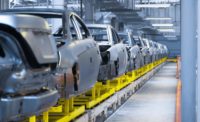GENEVA—The World Economic Forum recently named the best factories in the world. Five facilities are in Europe and three are in China. Only one is in the United States—UPS Fast Radius in Chicago.
The nine factories, representing both process and discrete manufacturing, were selected from a survey of more than 1,000 companies that are applying advanced technology in their operations.
“The aim of this effort is to build a network of ‘manufacturing lighthouses’ to address problems confronting industries…when it comes to investing in advanced technologies,” says Helena Leurent, head of the Shaping the Future of Production System Initiative and a member of the executive committee at the World Economic Forum.
Leurent claims that more than 70 percent of businesses investing in technologies such as additive manufacturing, artificial intelligence and data analytics do not take the projects beyond pilot phase due to unsuccessful implementation strategies. “The Fourth Industrial Revolution is expected to deliver productivity gains amounting to more than $3.7 trillion, but we are still at the beginning of the journey,” she explains.
“The Fourth Industrial Revolution is real,” adds Enno de Boer, partner and global head of manufacturing at McKinsey & Co., which collaborated with the World Economic Forum on the project. “Workers and management equally get augmented with technology. These pioneers have created factories that have 20 percent to 50 percent higher performance and create a competitive edge.
“They have agile teams with domain, analytics, Internet of Things and software development expertise that are rapidly innovating on the shop floor,” says de Boer. “They have deployed a common data platform and have up to 15 use cases in action. They are thinking scale, acting agile and resetting the benchmark.”
According to de Boer, each of the following nine factories “have comprehensively deployed a wide range of [advanced manufacturing] technologies” while keeping humans at the heart of innovation:
*Bayer Biopharmaceutical (Garbagnate, Italy). While most companies use less than 1 percent of the data they generate, Bayer’s massive “data lake” has led to a 25 percent reduction in maintenance costs and 30 percent to 40 percent gains in operational efficiency.
*Bosch Automotive (Wuxi, China). Bosch engineers are using advanced data analytics to understand and eliminate output losses, simulate and optimize process settings, and predict machine interruptions before they occur.
*Haier (Qingdao, China). Artificial intelligence-based transformations at this appliance manufacturer include an “order-to-make” mass customization platform and a remote AI-supported, central intelligent service cloud platform to predict maintenance needs before they happen.
*Johnson & Johnson Depuy Synthes (Cork, Ireland). This orthopedic implant factory used the Internet of Things to make old machines talk to one other, resulting in 10 percent lower operating costs and a 5 percent reduction in machine downtime.
*Phoenix Contact (Bad Pyrmont and Blomberg, Germany). By creating digital copies of each customer’s specifications, production time for repairs or replacements has been cut by 30 percent.
*Procter & Gamble (Rakona, Czech Republic). A click of a button is all it takes for production lines in this flexible factory to instantly change the product being manufactured. This has reduced costs by 20 percent and increased output by 160 percent.
*Schneider Electric (Vaudreuil, France). Sharing knowledge and best practices across sites has helped this factory achieve energy and operational efficiencies, reducing energy costs by 10 percent and maintenance costs by 30 percent.
*Siemens Industrial Automation Products (Chengdu, China). Using 3D simulation, augmented reality and other techniques to perfect operations, this plant increased output by 300 percent and reduced cycle time.
*UPS Fast Radius (Chicago). Meeting increasing consumer demand for fast-turnaround, customized products has been made possible through a combination of globally distributed 3D printing centers with real-time manufacturing analytics.
“To aid the learning and adoption of technologies by other companies, all nine [factories] have agreed to open their doors and share their knowledge with other manufacturers,” says Leurent.




